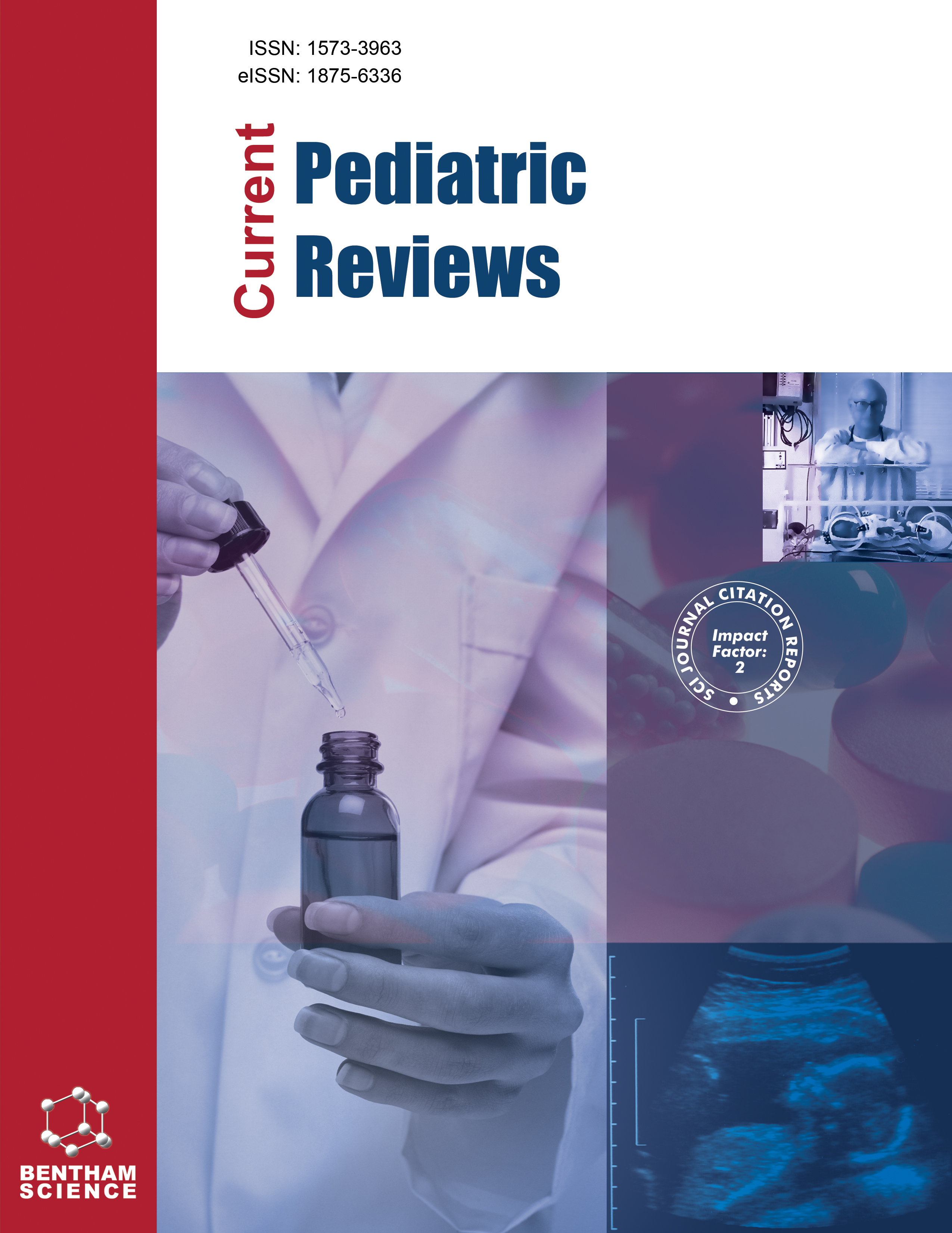- Home
- A-Z Publications
- Current Pediatric Reviews
- Previous Issues
- Volume 10, Issue 3, 2014
Current Pediatric Reviews - Volume 10, Issue 3, 2014
Volume 10, Issue 3, 2014
-
-
Thrombotic Complications of Neonates and Children with Congenital Nephrotic Syndrome
More LessAuthors: Keith K. Lau, Howard H. Chan, Patti Massicotte and Anthony K. ChanCongenital nephrotic syndrome (CNS) refers to a disease presenting with massive proteinuria in association with hypoalbuminemia, hyperlipidemia, and edema at birth or within the first three months of life. In the past, most children with CNS had extremely poor prognosis and succumbed to various complications, usually within the first 6 months. Recent advancements in protein supplementation and nutritional support, renal Read More
-
-
-
Is Red Meat Required for the Prevention of Iron Deficiency Among Children and Adolescents?
More LessAuthors: Savvas C. Savva and Anthony KafatosIron deficiency remains the most common nutritional deficiency worldwide despite the fact that global prevention is a high priority. Recent guidelines suggest intake of red meat both in infants and toddlers to prevent iron deficiency. However frequent consumption of red and processed meat may be associated with an increased risk for cancer, cardiovascular disease and diabetes. Evidence also suggests that even in veg Read More
-
-
-
Issues Impacting Therapeutic Outcomes in Pediatric Patients: An Overview
More LessAuthors: Atin Kalra and Shishu GoindiThe quest for achieving optimal therapeutic outcomes in pediatric patients has evaded the healthcare professionals for long and often lack of child specific dosage forms and the associated events that follow with it have been considered to be major contributor towards suboptimal outcomes. Consequently, there have been sustained efforts over the years to address this issue with the enactment of legislations like Best Pharma Read More
-
-
-
Chvostek's Sign in Paediatric Practice
More LessAuthors: Zeeshaan U. Hasan, Rania Absamara and Mas AhmedChvostek’s Sign was first described in 1876, as a clinical clue associated with patients who suffered from latent tetany, and is induced by percussion of the angle of the jaw. However, over the years many clinicians have called into question the strength of the association with latent tetany, particularly in paediatric practice. This review examines the variation in techniques used to elicit the sign in studies conducted on this ph Read More
-
-
-
Rhinosinusitis in the Pediatric Patient with Cystic Fibrosis
More LessAuthors: Christopher Fundakowski, Rosemary Ojo and Ramzi YounisCystic fibrosis (CF) is a common autosomal recessive genetic disorder where a deletion mutation and subsequent downstream alteration in transmembrane regulator proteins results in increased mucus viscosity. CF manifests clinically with chronic multisystem inflammation and recurrent infections. Nearly all children with CF have chronic sinusitis, and a large majority will have concurrent sinonasal polyposis. Chronic sinusit Read More
-
-
-
The Role of Oxidative Stress on Necrotizing Enterocolitis in Very Low Birth Weight Infants
More LessNecrotizing enterocolitis (NEC) is a devastating and common disease of very low birth weight (VLBW) infants with a mortality rate of 10% to 50% and a significant cause of morbidity in survivors. The incidence of NEC has increased from 5% to 7% in the last decades and this rate is likely to rise because of the increased survival of infants born at 24 weeks gestation, which are at high risk of developing NEC. NEC etiology is multifa Read More
-
-
-
Early Adversity and Mental Health: Linking Extremely Low Birth Weight, Emotion Regulation, and Internalizing Disorders
More LessAuthors: Jordana Waxman, Ryan J. Van Lieshout and Louis A. SchmidtThe experience of early adversity can increase one’s risk of psychopathology later in life. Extremely low birth weight (ELBW) provides a unique model of early adversity that affords us the opportunity to understand how prenatal and early postnatal stressors can affect the development of emotional, biological, and behavioural systems. Since the neuroendocrine system and emotion regulation can both be negatively affecte Read More
-
-
-
Clinical Pharmacology of Ibuprofen and Indomethacin in Preterm Infants with Patent Ductus Arteriosus
More LessBackground: Ibuprofen and indomethacin are potent non-selective cyclo-oxygenase inhibitors and inhibit prostaglandin E2 synthesis. The patent ductus arteriosus (PDA) occurs in more than 70% of preterm infants weighing <1500 g. Prostaglandin E2 relaxes smooth muscle, tends to inhibit the closure of PDA, yields vasodilatation of the afferent renal arterioles and maintains glomerular filtration rate (GFR). Ibuprofen and ind Read More
-
-
-
A Review of the Management of Lymphangiomas
More LessAuthors: Jennifer Ha, Yu-Ching Yu and Francis LanniganIntroduction: Lymphangioma is a rare benign cyst caused by congenital malformation of the lymphatic systems that often occurs in the cervicofacial region. There is no consensus on its management: Observation, aspiration, injection, cryotherapy, electrocautery, radiation, laser, ligation and excision. Methods: We performed a literature search with the keywords “cystic hygroma”, “lymphangioma”, “management” Read More
-
Volumes & issues
-
Volume 21 (2025)
-
Volume 20 (2024)
-
Volume 19 (2023)
-
Volume 18 (2022)
-
Volume 17 (2021)
-
Volume 16 (2020)
-
Volume 15 (2019)
-
Volume 14 (2018)
-
Volume 13 (2017)
-
Volume 12 (2016)
-
Volume 11 (2015)
-
Volume 10 (2014)
-
Volume 9 (2013)
-
Volume 8 (2012)
-
Volume 7 (2011)
-
Volume 6 (2010)
-
Volume 5 (2009)
-
Volume 4 (2008)
-
Volume 3 (2007)
-
Volume 2 (2006)
-
Volume 1 (2005)
Most Read This Month
Article
content/journals/cpr
Journal
10
5
false
en


